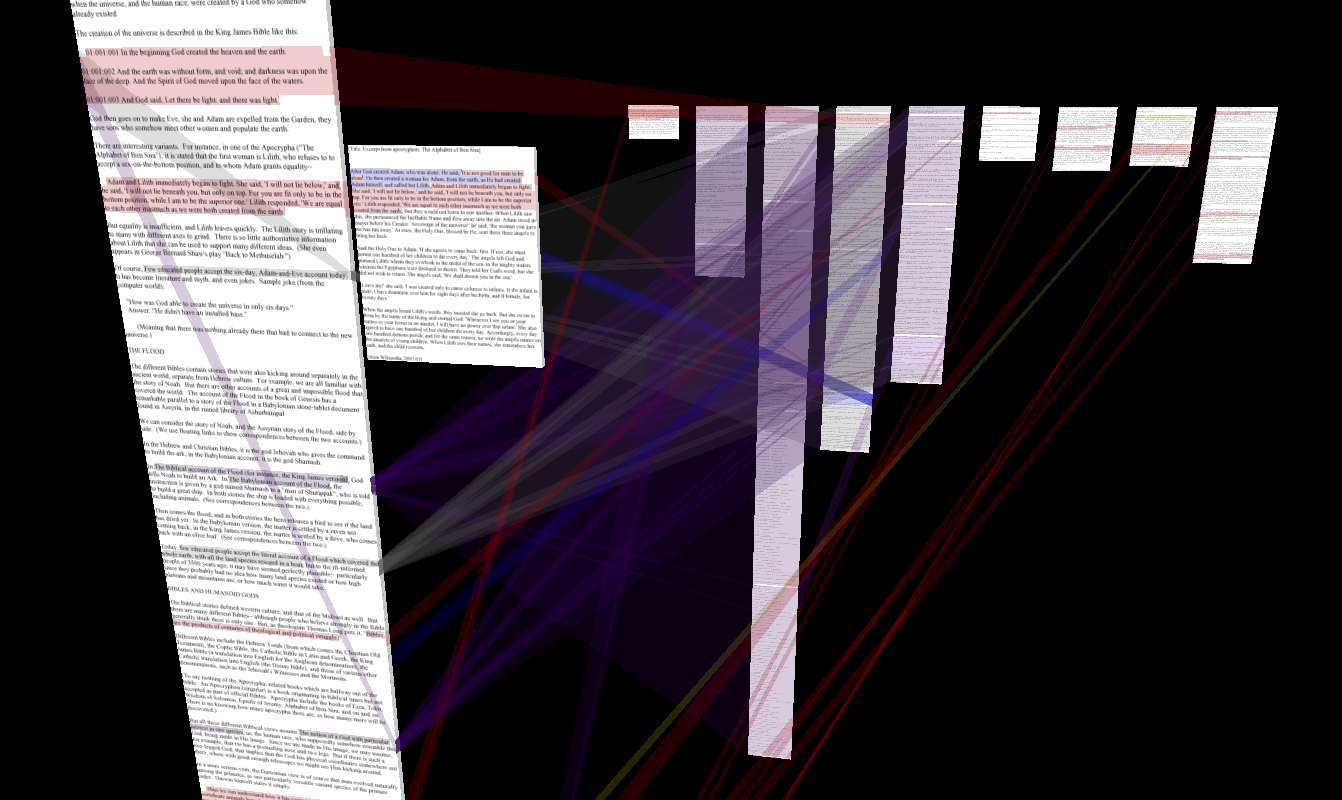Hypertext Writing📄📄
First published on .
Every medium has its strengths. There are considerable strengths inherent to a digital, web-based, way of thinking — first and foremost is the sheer amount of interactivity and connections you can make.
Now some of these strengths are not inherent to the web. As Ted Nelson points out in his video Visible Connection the written word has used its ability to provide context visually through side by side content, marginalia, paragraph summaries and more ever since the Rosetta Stone.Don’t forget about the footnote/endnote.
But the web allows writers to do crazy things like use bidirectional links, or have additional content appear when hovering over text, or reference the text of entire books like The King James Bible or The Complete Works of William Shakespeare with short little hyper links.
Our capabilities seem endless and new innovations and tools with new capabilities appear every week.Check out this growing list of tools for networked thinking.The key with any medium is knowing what its strengths are and knowing when something might be cool, but not useful. The law of unintended consequences still applies to the internet.
Links distract your reader
What are the side effects of links? A flood of information can end up distracting readers. Dense links are helpful for your notes, but are they helpful to the person trying to follow a logical train of thought in a carefully constructed article?
Links interrupt the flow of a reader’s thought — that is their inherent strength and weakness. In all writing it’s important to know when a new concept is introduced,Every new concept threatens to lose a reader who doesn’t understand or offers them an opportunity to learn. Good writing weaves around potential new concepts, but it also knows its audience and doesn’t explain every little thing. and links provide a convenient way to introduce new concepts — linking directly to the sources that helped the writer understand a concept. However, every time a link is offered, a reader is offered a door down a rabbit hole from which they might never emerge.
Ted Nelson and other internet thinkers have leaned heavily on links — Project Xanadu’s promise of visual connection to every source referenced in a text sounds great in theory, but the reality is an interconnected web of colored lines that is difficult to interpret. It is cool technology, but does it actually help the reader?Of course this will vary from reader to reader. Project Xanadu, indeed the very concept of hypertext was created by Ted Nelson to help channel his Attention Deficit Disorder. See “The Curse of Xanadu”, Wired

Links dilute meaning
The other danger is that the sheer amount of links will dilute what is communicated. On a practical level, sometimes it is easier to pay attention to the meaning of a text if it is all one color. Furthermore, one of the most valuable things I learned from my English degree was that it is sometimes better to assert my opinion without without any hedging or hiding what I actually think — and at least for me, references or links are a way of hiding behind someone else’s thoughts.
If you don't state your opinion, what sets your writing apart?
Of course there has to be a balance — and in an age where anyone can have a platform to say anything, it is important to know what you know, but also what other people might know better.
Writing in hypertext is valuable
Of course throughout this essay I’ve been using links as I write, because while I do believe that links could be a distraction and that they can dilute meaning, I also firmly believe that it is not my job to decide what you the reader can handle and somehow trick you into reading every word I’ve written. I write knowing that you might have followed my link to the 1995 Wired Article on Ted Nelson that was buried in a footnote up above, and you might not come back after opening that link…that’s just fine.I lost an hour when I first discovered that article, and I still want to go back and finish reading it.
As a writer the internet medium has strengths that I haven’t fully utilized before. I believe this digital format allows all of us — writers and readers — to make connections in new ways and explore ideas robustly. Certainly it is important to know the power of putting a link in place and limitting the number of linksFor an example of an essay that does this well, checkout Hypertext Gardens: Delightful Vistas to what could be reasonably explored — but if each link represents an idea worth exploring, then who am I to prevent exploration.
As I wrote this post I explored different notes I’ve written about these subjects as well as other resources, and that process helped me make new connections and improved both my understanding and this article. It comes at the cost of distraction, but that cost was there in the old medium too — anyone who has lost hours in a library as a child knows that it has always been possible to fall down a rabbit hole and discover the worlds that are buried underneath.
Further Reading
- Maggie Appleton’s Short History of Bidirectional Links
- Ted Nelson’s Video Series on Project Xanadu, beginning with Visible Connection
Other things to read
- Create a Basic Svelte SiteA short guide to creating a simple Svelte site with animations and transitions.
- Editing a Year"Good writing is editing." I know this is true. There are many thoughts that can be expressed more simply and many more that don't need to…
- 2022 - The year of the blog?2022 the year we hope the pandemic finally comes to an end, a year of new hope, of midterm elections (what already?), a year of new jobs…